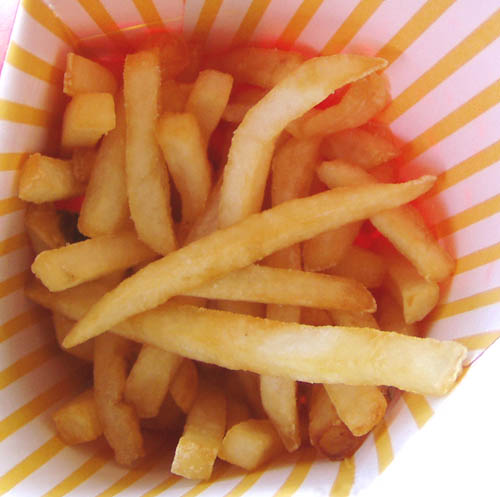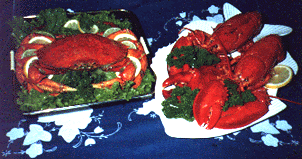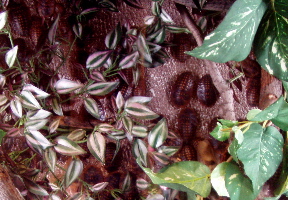
NO, PEOPLE DIDN'T
INVENT POLYMERS.
 You may think that polymers are so common that they grow on trees... Well, you're right. When we say that polymers are everywhere, we mean it. In fact polymers have been in nature from the beginning. All living things - plants, animals, and people - are made of polymers.
You may think that polymers are so common that they grow on trees... Well, you're right. When we say that polymers are everywhere, we mean it. In fact polymers have been in nature from the beginning. All living things - plants, animals, and people - are made of polymers.
There are lots of polymers in the sea. Click here to visit the Polyquarium.
Let's start with plants.
Polymers in Plants
 Plants are made of a polymer called cellulose. This is the tough stuff that wood and stems - and Paul's tree house! - are made from. Cellulose is also what makes fibers like cotton and hemp that we can twist into threads and weave into clothing. And many plants also make starch. Potatoes, corn, rice, and grains all have a lot of starch. Starch is also a polymer.
Plants are made of a polymer called cellulose. This is the tough stuff that wood and stems - and Paul's tree house! - are made from. Cellulose is also what makes fibers like cotton and hemp that we can twist into threads and weave into clothing. And many plants also make starch. Potatoes, corn, rice, and grains all have a lot of starch. Starch is also a polymer.
Even though starch and cellulose are both made from the same sugar (glucose), they act very differently (because the glucose molecules are joined together differently). Starch will dissolve in water, but cellulose won't. So we make food from starches and we build things and make clothing out of cellulose.

 Starch is all twisted up in a tight blob, with lots of branches and ends sticking out all over. Starch is really just a compact way to store a lot of glucose in a small space. Our bodies break the starch down into glucose, which can be used for energy so you can run and jump and play and think.
Starch is all twisted up in a tight blob, with lots of branches and ends sticking out all over. Starch is really just a compact way to store a lot of glucose in a small space. Our bodies break the starch down into glucose, which can be used for energy so you can run and jump and play and think.
Plants use cellulose for strength. The cellulose chains are all stretched out, and like to stay tight right next to each other, like raw spaghetti that's all stuck together. That's why cellulose can hold up the tallest trees! And wooden houses too! Cotton is mostly cellulose - those stretched-out chains make great fibers.
The cellulose in vegetables and grains is the fiber in our foods. We can't digest it, but it's good for us because it helps keep our insides clean.
Cellulose and starches are both made from sugars - so they're called polysaccharides (meaning "many sugars").
Another useful natural polymer produced by plants is rubber. It has been harvested from trees in Central and South America for hundreds of years. In the last couple hundred years people have figured out ways to make it stronger and more durable. And scientists have been very successful in inventing their own versions of rubber for different purposes.
Polymers in People - and all kinds of animals, too ...
Protein
 You know they say "You are what you eat." Well, one natural polymer that we eat a lot of is also one we are made of - PROTEIN! Protein also forms some of the things you wear - namely leather, silk, and wool. Protein is a natural polymer formed from molecules called amino acids. Chicken nuggets and hamburgers have a lot of protein (but the bun has a lot of starch!). Protein is the main thing in skin, organs, muscles, hair and fingernails. The most common protein in your body, collagen, is used for support and structure. It's in-between all the cells in your body, all around your organs, even in your teeth and bones.
You know they say "You are what you eat." Well, one natural polymer that we eat a lot of is also one we are made of - PROTEIN! Protein also forms some of the things you wear - namely leather, silk, and wool. Protein is a natural polymer formed from molecules called amino acids. Chicken nuggets and hamburgers have a lot of protein (but the bun has a lot of starch!). Protein is the main thing in skin, organs, muscles, hair and fingernails. The most common protein in your body, collagen, is used for support and structure. It's in-between all the cells in your body, all around your organs, even in your teeth and bones.
 Feathers and fur, hair and fingernails (even animal hooves), are all made of the protein keratin. Wool is made from sheep hair, and is great for clothing and fabric. Wool is warm and sometimes a little itchy, but it's still widely used. You'll find it everywhere from hats to skirts to the inside of a piano... and of course in sweaters.
Feathers and fur, hair and fingernails (even animal hooves), are all made of the protein keratin. Wool is made from sheep hair, and is great for clothing and fabric. Wool is warm and sometimes a little itchy, but it's still widely used. You'll find it everywhere from hats to skirts to the inside of a piano... and of course in sweaters.  In fact many kinds of animal hair besides wool have been used to make clothing. Angora rabbits have extra light, soft, fluffy fur. Cashmere is a wool that comes from special goats, and is very soft and long-wearing. Alpacas and llamas also produce wool that's soft and warm.
In fact many kinds of animal hair besides wool have been used to make clothing. Angora rabbits have extra light, soft, fluffy fur. Cashmere is a wool that comes from special goats, and is very soft and long-wearing. Alpacas and llamas also produce wool that's soft and warm.

Silk
Another great protein is silk - a sort of fiber made by special caterpillars. This stuff has been used for thousands of years to make beautiful fabric for clothing. And though people have made their own version of silk called nylon, there's still nothing out there quite like silk. Spider silk is incredibly strong for its weight, and scientists have been working hard to mimic this fiber, too.
Enzymes
A special group of proteins that work inside the body are enzymes. Each enzyme is a specific little glob of a protein that does a specific job in the body, and does it really really fast. Without enzymes, these jobs either just wouldn't happen, or would go way too slowly to make life possible! Some enzymes even make other enzymes. The enzymes all work together to keep everything in your body going, like processing your food into energy so you can chase your little brother around. Click here to see how you can taste enzymes working.
Chitin (sounds like kite - inn)
What do lobsters and giant cockroaches and mushrooms have in common?
Chitin!



Chitin is the strong waterproof stuff that crustaceans like crabs and shrimp and all kinds of bugs make to form their protective outer shells. It's even found in the cell walls of mushrooms (weird, huh?!). The neat thing about chitin is that its structure is a lot like cellulose. One might think it would be a protein since it's made by animals (mostly), but it's more like the tough stuff in plants. Scientists have found a way to purify the chitin into an off-white powder that can be useful to farmers, doctors, and even in food as a thickening agent. To learn more about polymers in the sea, click here to visit the Polyquarium.
Here's a Question for You
From what you know now about natural polymers, can you guess which two are the most common in the whole world? Click here for the answer.
Natural Polymers Changed by People
Some of the first polymers made by people were made from natural polymers, like the cellulose nitrate movie film made from cellulose. Later this film was replaced by safer, less explosive, cellulose acetate. And acetate film is still used in movie cameras today. Cellulose is also used to produce the synthetic fibers in rayon, which just might be in some of your clothing.
Natural Polymers as Inspiration to Make (or improve) Polymers
Another way that natural polymers influenced synthetic polymers was during shortages, like during World War II when there wasn't enough silk or rubber to go around because we were at war with the countries that produced them. So people figured out ways to make their own polymers similar to these natural products - namely nylon and synthetic rubbers. New processes such as crosslinking were invented to improve natural polymers. Crosslinking rubber makes it stronger and keeps it from melting when it gets hot.

Copyright © 2003 |
Polymer Science Learning Center
| Department of
Polymer Science | University of
Southern Mississippi
 You may think that polymers are so common that they grow on trees... Well, you're right. When we say that polymers are everywhere, we mean it. In fact polymers have been in nature from the beginning. All living things - plants, animals, and people - are made of polymers.
You may think that polymers are so common that they grow on trees... Well, you're right. When we say that polymers are everywhere, we mean it. In fact polymers have been in nature from the beginning. All living things - plants, animals, and people - are made of polymers.

 Plants are made of a polymer called
Plants are made of a polymer called 
 Starch is all twisted up in a tight blob, with lots of branches and ends sticking out all over. Starch is really just a compact way to store a lot of glucose in a small space. Our bodies break the starch down into glucose, which can be used for energy so you can run and jump and play and think.
Starch is all twisted up in a tight blob, with lots of branches and ends sticking out all over. Starch is really just a compact way to store a lot of glucose in a small space. Our bodies break the starch down into glucose, which can be used for energy so you can run and jump and play and think.
 You know they say "You are what you eat." Well, one natural polymer that we eat a lot of is also one we are made of - PROTEIN! Protein also forms some of the things you wear - namely leather, silk, and wool. Protein is a natural polymer formed from molecules called amino acids. Chicken nuggets and hamburgers have a lot of protein (but the bun has a lot of starch!). Protein is the main thing in skin, organs, muscles, hair and fingernails. The most common protein in your body, collagen, is used for support and structure. It's in-between all the cells in your body, all around your organs, even in your teeth and bones.
You know they say "You are what you eat." Well, one natural polymer that we eat a lot of is also one we are made of - PROTEIN! Protein also forms some of the things you wear - namely leather, silk, and wool. Protein is a natural polymer formed from molecules called amino acids. Chicken nuggets and hamburgers have a lot of protein (but the bun has a lot of starch!). Protein is the main thing in skin, organs, muscles, hair and fingernails. The most common protein in your body, collagen, is used for support and structure. It's in-between all the cells in your body, all around your organs, even in your teeth and bones.
 Feathers and fur, hair and fingernails (even animal hooves), are all made of the protein
Feathers and fur, hair and fingernails (even animal hooves), are all made of the protein  In fact many kinds of animal hair besides wool have been used to make clothing. Angora rabbits have extra light, soft, fluffy fur. Cashmere is a wool that comes from special goats, and is very soft and long-wearing. Alpacas and
In fact many kinds of animal hair besides wool have been used to make clothing. Angora rabbits have extra light, soft, fluffy fur. Cashmere is a wool that comes from special goats, and is very soft and long-wearing. Alpacas and 




